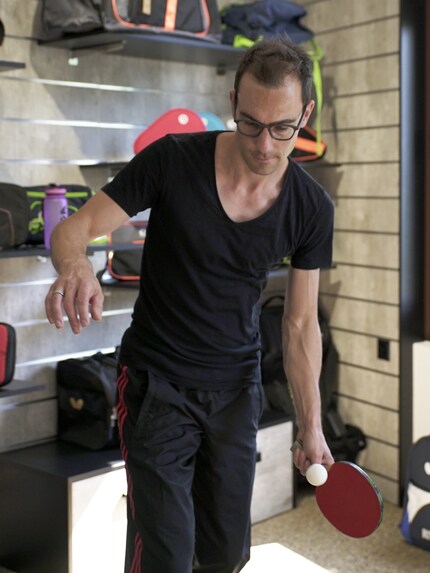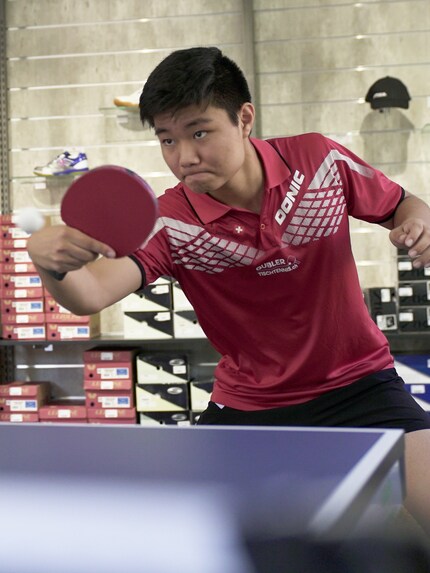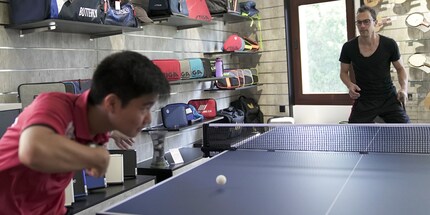
Guide
My corpse in the cupboard
by Michael Restin
Table tennis is celluloid* at speed. Incredibly fast. My duel with U18 national player Pedro Osiro is above all: over incredibly quickly. There's enough time afterwards to give me a few tips and teach me how to serve properly.
Pedro makes the ball dance, I flail wildly against it. The little celluloid ball is his world, I'm something between a teammate and a cue ball. But there's one thing I'm certainly not: an opponent. Nevertheless, I ask him to a duel. Opposite me is Pedro Osiro Shinohara, 16 years old, multiple Swiss youth champion and member of the U18 national team. For him, the table tennis racket is like an extra body part. My old racket is stored somewhere in the cellar and was last used regularly when Pedro was just born.
We play a set. No mercy please. I serve, Pedro smiles - and serves me off by every trick in the book. No matter what I try, the ball comes back with so much speed and spin that I only manage a short rally with a bit of luck. When Pedro serves, the damn ball bounces somewhere, only once do I get a return on the board. The dismantling takes just under a minute and a half, including picking up the balls, and then it's 1:11. You can watch my debacle from every conceivable perspective in the video.
The point of honour is a gift, Pedro makes a mistake on his serve. Perhaps out of politeness, perhaps because he had returned late the night before from the European Youth Championships in Romania. With the U18 team, he achieved 15th place there and thus promotion to the first division, a success. In the singles, he reached the second main round. "Overall, I'm happy with that," says Pedro. I'm satisfied too. I didn't stand a chance against him - but I had a lot of fun.
So that's table tennis, if you can do it properly. Awesome sport. I want more. And learn something. What can I do better? Sure, basically everything. But I have to start somewhere. "Don't make such big strokes, don't go all out," says Pedro, who now slips into the role of coach and passes me the balls so that I can slowly find a kind of rhythm. "Just keep it relaxed." That's right, of course. My shots have the spread of a shotgun, for me it should primarily be about control.
This works much better with small movements from the forearm and wrist, as Pedro shows me. Nevertheless, I still get carried away with wild punches that miss their target 95 per cent of the time and force Pedro to make one or two evasive manoeuvres. The desperado tactic of all recreational players. As soon as the ball is in play, hit it and hope for a chance hit. All or nothing. Only nothing usually comes of it.


Pedro's punches, on the other hand, look pretty perfect to me. But he also answers the question of what still separates him from the top players: "They make a lot fewer easy mistakes." Of course, with even more hardness and even more spin. Pedro also wants to get there: "My goal is to be able to make a living from table tennis," he says firmly. To achieve this, he trains five to six hours a day under professional conditions, far away from home: "After I finished year 9, I went to Sweden," he explains. At the Eslövs AI BTK academy, he is fully committed to the sport. "I can concentrate 100 per cent on table tennis there and the training partners are also at a high level."
The legs have to be strong.
There's no question of a high level here today. While Pedro is light on his feet and ready for any reaction, my feet are glued to the ground. "Get lower to your knees and stand on the balls of your feet," is his advice. The more I try to take Pedro's advice to heart and study his movements, the more I realise how much everything is in flow with him. A perfectly synchronised system in which the racket lies loosely in the hand and sends the ball on its way with precision time and time again. What does a change of material mean? "When I change the surface, it takes me one to two weeks to get used to it," says Pedro. "I also want to switch to a faster blade soon, which is harder and heavier. I can put more pressure on it."

More pressure? For me, the racket hasn't been something I've given much thought to so far. There's a red side, a black side and the rubber should have some kind of grip. That's it. I thought. But of course it's not that simple. My meeting with Pedro takes place at our partner Tischtennis Gubler in Winznau, where a new world of millions of possible rubbers, blades and combinations opens up to me.
I have been given a model that is primarily designed for game control and to forgive mistakes. No material in the world can simply iron out my weaknesses, but it's a completely different feel to playing with my beat-up old trowel in the basement. If your playing style is similar to mine and you're looking for a new racket, at least take the time to study the playing characteristics in the description and critically compare them with your own ability. It's worth it.
An overview of all amateur rackets
Pedro plays with a professional model customised to his game, whose rubbers he replaces once a month. I could do little to nothing with his racket, even though the material is significantly more expensive. That's the good news: as an amateur, you can get away cheaper and are better off with it. However, if you play regularly, you should still change the rubber at least once a year.
Finally, I ask Pedro to tell me one more secret. The secret of a good serve. He plays many different variations himself and when he serves, the balls have so much spin that I can never really judge them. When I ask him which one I could learn, he has to think a bit and then shows me the sidecut serve with the forehand. Sounds good. I see that he picks up the racket differently and makes a quick flick of the wrist. But how exactly does it work? Here he shows you and me step by step.
After a few attempts, the serve doesn't work too badly. A sense of achievement! But I also enjoyed the lesson, I want to pick up the racket more often again. And Pedro is doing everything he can to make his table tennis career a success anyway. In addition to training in Sweden, he will also be competing in the regional league in Germany for TTC Bietigheim-Bissingen. He's a quiet guy who sets himself high goals and has a lot of ambition. I'm keeping my fingers crossed that he makes it to the top and that he keeps the fun in it. What role does your head actually play when it comes to delivering your performance? "At the end of the day, you can do it in the match or you can't," says Pedro succinctly. That's right. I can't do it. Neither in my head nor with the bat. But I can understand his fascination for table tennis.
Note:
I really outed myself as a dilettante with the word *celluloid. Because table tennis balls are no longer made from celluloid, but from ABS or other materials, writes Daniel Gubler from Tischtennis Gubler. And that's a good thing. After all, celluloid burns like tinder and has been responsible for several fire disasters. Table tennis balls as dangerous goods - fortunately, that no longer has to be the case today.
Simple writer and dad of two who likes to be on the move, wading through everyday family life. Juggling several balls, I'll occasionally drop one. It could be a ball, or a remark. Or both.
Interesting facts about products, behind-the-scenes looks at manufacturers and deep-dives on interesting people.
Show all